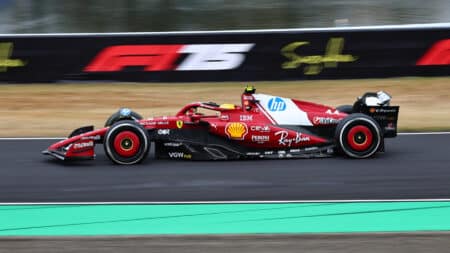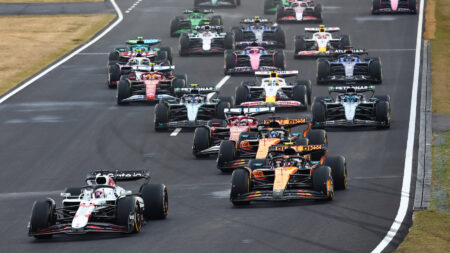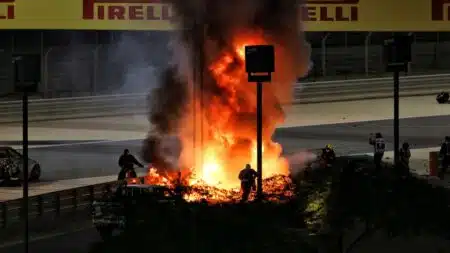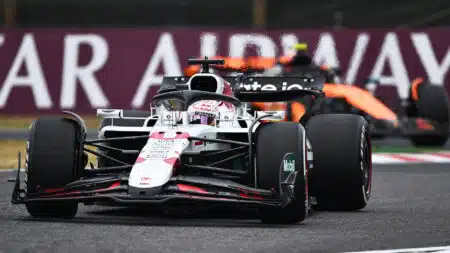
The Ferrari updates Hamilton hopes will fix his car problems in Bahrain
Ferrari is the Formula 1 team bringing the biggest update for its car in the Bahrain Grand Prix
Some things don’t change in Formula 1. It’s more than 10 years since I attended European Grands Prix on a regular basis, following the old Formula 3000 circus as it supported the main act from Imola in April to Monza in September. Like the drivers I was writing about, the experience gave me my first taste of life on the F1 road – and it was invaluable for everything that’s come since.
These days, I am an irregular visitor to F1 paddocks, a voyeur dropping in on a familiar world, and what always strikes me is just how little changes. Yes, there are some new faces – but there are a lot of old ones, too.
In the press room, the friends I made who have the stamina I’m obviously lacking are still scratching a living at the jobs they wouldn’t swap for anything. The banter, the irreverence, the school-yard teasing and sniping, the odd character who takes himself way too seriously…
It’s a dysfunctional family of dedicated eccentrics, independent souls – and, frankly, the odd weirdo. And it’s great.
In Barcelona at the weekend, I also made a point of visiting the support paddock just as I used to, partly for old time’s sake, partly to catch up with an old mate and largely to take a closer look at the modern generations of Porsche Supercup cars, GP2 single-seaters and the new GP3. This was the third 2013 round of GP2 following the races in Malaysia and Bahrain, but the first for the new-look Porsches and the third-string single-seater series.
Again, little had changed from the old F3000 days. Among the mechanics and engineers buzzing around, there were a lot of familiar faces – although the hospitality tents had grown a bit. F3000 never had such a luxury, but Porsche’s old motorhome had grown into a palace of fine food and fancy furnishings. It puts some serious budget into the Supercup, does Porsche.
Of course, the result of all these extras, not to mention an increase of three rather than two championships, is a paddock even more cramped than I remember it. Good old Formula One Management hasn’t opened up more space for the support series. Oh no. It’s all crammed in the same corner it’s always been, with just about enough width for a single-seater between the wall-to-wall transporters.
The old F3000 teams always felt like the forgotten poor relations at Grands Prix. It doesn’t look like that has changed much either.
But at least the racing was better. On Sunday, there was some criticism of the GP2 race, but it was a sight more entertaining than F3000 at the same circuit back in the day. One year, I recall watching a race that featured not one overtaking move. It was painful.
In both GP2 and GP3, the racing is super-competitive, but the caveat is that driving standards need a firm hand. The antics of some were split between incompetence and sheer stupidity, although credit to the majority, particularly in GP3, who kept it both clean and entertaining.
And unlike in F1, at least you could believe in what you were watching. But even here, Pirelli tyres are the dominant factor, as young Scot Lewis Williamson explained to me.
Typically of his generation, Williamson is a racing veteran at the grand old age of 23. He began karting at eight and was tipped for great things in 2010 when he won the McLaren Autosport BRDC young driver competition. But also typically of his era, Lewis has struggled to maintain career momentum because of the challenge of finding a mortgage-sized budget each year. In the recent past he’s stalled in both the Formula Renault World Series and GP3, but has now landed a late deal to try again in the F1 support series with the newly-formed Bamboo Engineering squad.
Eleventh and ninth place finishes in Barcelona were hardly stellar, but his drive was only confirmed in the week ahead of the first race. Expectations are high for the races to come.
“The fundamentals of the car this year are similar and balance-wise it doesn’t feel that different,” he said of the new-generation Dallara. “The massive gain is the engine, which is awesome. The way you drive the car is different from last year, with no turbo and being normally aspirated. For me it’s an overall better car.”
It should also be mentioned they sound a lot better, too. Much more like a racing car, much less anaemic. Power has risen from 280 to 400hp, so it’s more relevant as a stepping-stone to GP2 – and of course to F1 as well.
“I was in the series for a few races last year and the year before,” said Williamson. “There’s a lot of good kids in the championship, which is awesome. And now having more power has brought another element to the racing. Tyre management wasn’t so crucial last year.
“As the races here showed, the tyre begins to come into its own as the race goes on. And the people who have been sensible with them then start to pick up places, because the tyre drops off that much. It’s worth being a couple of tenths off in the first couple of laps and not pushing as much, to then gain in seconds at the end. But really it’s a guessing game.”
Sound familiar?
“It has become a tyre formula, more than we’ve had before,” Lewis explained. “It doesn’t feel great when you’re driving. But a lot of it is comedy value because you do see a lot of people dropping off massively, and then it’s like taking candy from a baby.
“For the drivers, it doesn’t feel that great when you’re sliding around and you really have to back off when it’s not in your instinct to.”
It’s a sentiment with which the other Lewis, the one in the slightly less cramped paddock a few hundred yards away, would certainly concur. With tyre degradation so vital at the top of the sport, clearly the sooner the next generation get used to compromise and poor performance the better.
Do you get the feeling something’s gone wrong in our sport?

Ferrari is the Formula 1 team bringing the biggest update for its car in the Bahrain Grand Prix

The FIA says engine manufacturers have committed to the planned 2026 rules, with some modifications

Over the years, the Bahrain Grand Prix has offered plenty of on-track - and some off-track - drama. These are the top controversies from the Sakhir event

The top three were covered by 2sec in the previous race, and big points were scored elsewhere – who's in your 2025 Bahrain GP Fantasy team? Here are our predictions; tips on drivers to avoid; which chips to play and further analysis